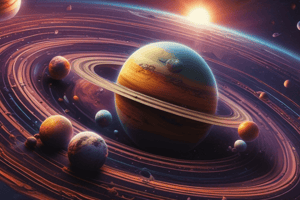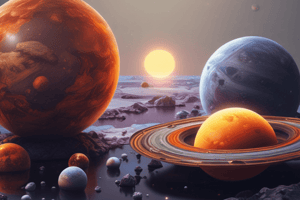Podcast
Questions and Answers
Which inner planet is unique for having a magnetic field due to its molten iron core?
Which inner planet is unique for having a magnetic field due to its molten iron core?
- Mercury
- Venus
- Mars
- Earth (correct)
What distinguishes the formation of the inner planets from the outer planets?
What distinguishes the formation of the inner planets from the outer planets?
- The inner planets are larger in size compared to the outer planets.
- The inner planets condensed due to high temperatures from the Sun. (correct)
- The inner planets formed in cooler regions of the solar system.
- The inner planets formed from ice, gas, and rock.
Which planet is known for being the brightest planet in the night sky, after the Sun and the Moon?
Which planet is known for being the brightest planet in the night sky, after the Sun and the Moon?
- Mercury
- Mars
- Venus (correct)
- Earth
Which inner planet is unique for spinning clockwise or rotating backward?
Which inner planet is unique for spinning clockwise or rotating backward?
What characterizes the composition of the inner planets?
What characterizes the composition of the inner planets?
What distinguishes the inner planets from the other planets in our solar system?
What distinguishes the inner planets from the other planets in our solar system?
How were the inner planets formed according to the text?
How were the inner planets formed according to the text?
Which planet is the closest to the Sun among the inner planets?
Which planet is the closest to the Sun among the inner planets?
What is another name for the inner planets mentioned in the text?
What is another name for the inner planets mentioned in the text?
What common characteristics do the inner planets share according to the text?
What common characteristics do the inner planets share according to the text?
Which type of planets have rings around them?
Which type of planets have rings around them?
Why do outer planets have faster orbital speeds compared to inner planets?
Why do outer planets have faster orbital speeds compared to inner planets?
What is the primary composition of outer planets?
What is the primary composition of outer planets?
Which planets have a maximum of two moons around them?
Which planets have a maximum of two moons around them?
What is the significance of the frost line in the solar system?
What is the significance of the frost line in the solar system?
Flashcards are hidden until you start studying
Study Notes
Inner Planets
- Earth is unique among the inner planets for having a magnetic field due to its molten iron core.
- The inner planets are distinguished from the outer planets by their formation: they were formed through a process of collisions and mergers of smaller bodies in the early solar system.
Planet Characteristics
- Venus is the brightest planet in the night sky, after the Sun and the Moon.
- Venus is also the inner planet that spins clockwise or rotates backward.
Composition and Formation
- The inner planets are characterized by a composition of rock and metal.
- The inner planets were formed close to the Sun, where temperatures were too high for volatile compounds like water, ammonia, and methane to exist in solid form.
- The inner planets are also distinguished from the outer planets by their proximity to the Sun and their relatively small size.
Inner Planets Classification
- The inner planets are also known as the terrestrial planets.
- The common characteristics of the inner planets include their proximity to the Sun, small size, and composition of rock and metal.
Outer Planets
- Outer planets are characterized by having rings around them.
- Outer planets have faster orbital speeds compared to inner planets because they are more massive and have stronger gravitational pulls.
Composition of Outer Planets
- Outer planets are primarily composed of hydrogen and helium.
Moons of Outer Planets
- Some outer planets have a maximum of two moons around them.
The Frost Line
- The frost line is a significant boundary in the solar system, marking the distance from the Sun where temperatures are low enough for volatile compounds to exist in solid form.
- The formation of the inner and outer planets was influenced by their position relative to the frost line.
Studying That Suits You
Use AI to generate personalized quizzes and flashcards to suit your learning preferences.




